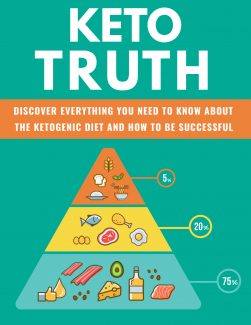 License Type: Private Label Rights
License Type: Private Label Rights  File Type: ZIP
File Type: ZIP
 SKU: 63970
SKU: 63970  Shipping: Online Download
Shipping: Online Download
Sample Content Preview
Introduction
You’ve probably heard about the keto diet, even if you may not know exactly what it entails.
It’s an ultra-low carb, high-fat diet that has shown promise in managing Type 2 diabetics and in weight loss.
But what’s all the fuss about? Is it really safe? Are there long-term effects, and can it really help you lose weight and keep it off?
We’ll explore the keto diet in this special report so you can Let’s decide for yourself whether this lifestyle change is right for you or not.
Let’s begin!
Keto Explained
The full name is the Ketogenic Diet, because it forces your body into a ketogenic state.
The ketogenic diet is a high-fat, low-carb diet originally invented back in the 1920s as a treatment for childhood epilepsy.
If you go on a ketogenic diet, you’ll be getting around 80% of your calories from fat, which the body burns as fuel when it can’t get carbs.
You’ll also be dropping your carb intake to about 5% of total daily calories and getting the rest of the 15-20% from proteins.
This is a fairly drastic departure from what we all learned in school as a healthy, well-balanced diet which typically consists of: 20-35% protein, 45-65% carbs, and only 10-35% fat.
While you follow a keto diet, your body will become very good at burning fat, which of course, is exactly what you want when you’re trying to lose weight.
It also helps turn your own fat into ketones in your liver, which your brain can use for energy. This diet is known to drastically lower blood sugar and insulin levels, which is where the diabetic benefits come in.
There are two basic types of keto diet: standard and high protein.
The standard diet is the one discussed above, with around 70-80% fat, around 20% protein, and only 5-10% carbs.
The high protein keto diet, just as it sounds, tweaks the proportions to add more proteins.
You drop the fat to around 60% and increase the protein percentage to 35%.
Bodybuilders and athletes often need more carbs for fast energy, so sometimes they’ll tweak, and play with that carb percentage.
Some of them will also follow what they call a cyclical keto diet, which follows the standard diet for a certain number of days, followed by a couple of higher-carb days. It’s often also called “carb cycling”.
Others will just increase the number of carbs they consume right before a workout (a targeted keto diet).
The standard and high-protein diets have been studied far more extensively than the cyclical or targeted diets, so in this special report, we’ll be mostly talking about the standard diet.
How (and why) This Works
In order to better understand how a keto diet works, let’s take a look at your digestive system and how it responds to fewer carbs.
When you eat carbs, found in anything from the fruit and vegetable families (and that includes products made from grains, like pasta, breads, and crackers), your digestive system breaks them down into glucose.
Glucose is used to provide energy for the body, and the digestive system isn’t particularly picky about where the glucose comes from.
It’ll digest a healthy salad in the same way as it would a candy bar, so it’s up to you to decide what to feed it.
This glucose is stored in a couple of ways in your body: as glycogen in the liver and muscle tissue, and as adipose or fat.
When your body can’t get sufficient carbs to turn into glucose, it will start to burn fat instead.
This metabolic state is called ketosis because one of the by-products of this fat-burning is the production of ketones, which can also be used for energy.
If you want to be super-scientific, you can get breath and urine tests that will show the presence of these ketones and prove that you’re doing the diet correctly.
Most people just follow along and trust that it’s working. You can also tell your body is producing ketones by the following side-effects of the process: increased thirst or dry mouth, increased urination, and a decreased appetite.
The most effective way to get your body into ketosis is to follow a ketogenic (keto) diet where you severely limit your carb intake (remember that 5%).
That’s around 20-50 grams a day. The rest of the time you fill up on fats and proteins like meat, fish, eggs, nuts, and healthy oils (like coconut or avocado).
It’s just as important to limit your protein intake, though, because if you eat too much protein, your body will sneakily start turning some of it into glucose, which it likes better than fat.
You can also enter ketosis by intermittent fasting, such as limiting your meals to an eight-hour period during the day and fasting the remaining sixteen hours.
The Top Benefits of a Keto Diet
As we previously mentioned, the keto diet was originally created to help with childhood epilepsy. It’s still used today, and children can actually have 30 to 40% fewer seizures by rigorously following the diet.
In addition to this disorder, the keto diet has been studied in several other conditions.
- License: Private Label Rights
- Category:Ebooks
- Tags:2021 Ebooks Private Label Rights








